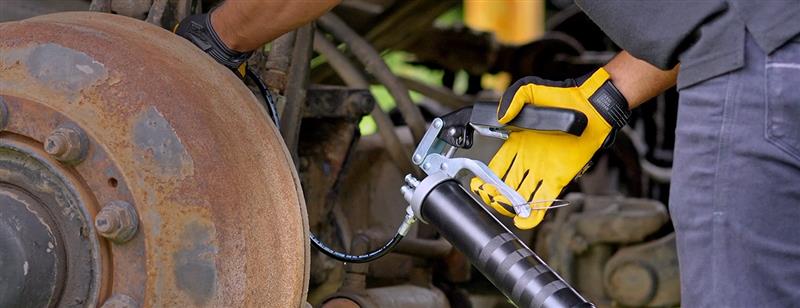
Choosing the Right Grease for Automotive Repair and Maintenance
Share
The Complete Guide to Automotive Grease for Repair Shops
In a busy automotive repair or service shop, every second counts—and so does every service performed. Whether you’re tackling a full collision repair or routine brake maintenance, the right grease keeps your operation safe, efficient, and profitable. It protects parts, reduces wear, and helps deliver quality work that lasts.
At Kent Automotive, we’re here to help fuel the success of your shop with our wide range of high-performance greases, carefully designed to meet the unique demands of modern auto repair and collision shops. Choosing the right grease doesn't just keep your equipment running smoothly–it keeps your business moving forward. In this guide, we’ll walk you through selecting the perfect grease for your applications and show you how to apply it with confidence, so your shop can deliver the performance your customers count on.
Understanding Automotive Grease and Its Uses
Automotive grease is a semi-solid lubricant made from base oil, a thickening agent, and performance additives. It's engineered to reduce friction and prevent wear in areas where oil might leak out or fail to stay put, like brake caliper pins, suspension joints, or chassis components.
Compared to industrial greases, automotive greases are specifically formulated for vehicle systems with frequent movement, temperature fluctuations, and exposure to road debris or water. While both types use similar thickener bases (like lithium or calcium sulfonate), automotive greases prioritize quick application, water resistance, and long-term protection for safety-critical systems.
Types of Grease Needed in Auto Repair and Collision Shops
Brake Lubrication:
Brake hardware requires a high-temperature grease for brakes that can withstand the heat generated during stopping. A product like Rusty 3000 is formulated specifically for brake lubrication and offers excellent resistance to water washout and long-life metal-to-metal contact in high-heat and high-moisture environments.
Suspension and Steering:
Joints, control arms, and bushings all benefit from a quality car grease that stays put, even under load. Multipurpose lithium complex or calcium sulfonate greases like Leverage work well here, especially in areas exposed to the elements. Leverage meets NLGI GC-LB performance specifications for wheel bearing and chassis lubrication.
Undercarriage and Hinges:
Door hinges, latches, and underbody connections need grease lubricant with rust protection and waterproof properties. Blue Grease HT is designed for heavy-duty exposure and won’t degrade in wet conditions.
Multipurpose vs. Specialty Grease:
Some tasks can be handled by a high-quality multipurpose grease but others—like brake calipers—need a product with specific heat and load resistance.
How to Select and Apply Grease Correctly
Using the right product is only half the equation—how you apply grease matters, too.
Grease Guns:
For precision and efficiency, shops should use reliable tools like the Heavy-Duty Pistol Grip Grease Gun or the Dual Pistol/Lever Handle Grease Gun, which can adapt to high-pressure or confined-space needs.
Avoid Over-lubrication:
Too much grease can cause seals to fail or attract debris. Apply just enough to coat contact points without excess.
Grease Compatibility Matters:
Mixing incompatible greases—such as switching from a lithium complex to a polyurea-based formula—can lead to breakdowns. Not all greases work well together. In fact, mixing incompatible formulas can cause a grease to break down entirely. The best practice to ensure optimal grease performance is to always purge your old grease. We encourage you to consult our team if you have questions!
Keeping Repair Shops Running Smoothly with the Right Lubricants
Stay on Schedule:
Greasing is often overlooked in routine maintenance. According to a recent AutoInc. survey, nearly 26% of drivers ignore sluggish brakes for a month or more, often leading to more expensive repairs.
Stock the Right Grease Types:
Don’t rely on a single tube of all-purpose grease for every application. Each part of the car—from brake calipers to hinges—has different demands. Shop managers should stock multiple types and label them clearly.
Grease Color ≠ Performance:
Contrary to popular belief, grease color doesn’t indicate quality or performance. It’s just a way to differentiate products. Learn more about this from Machine Lubrication.
Use OEM Approved Products When Possible:
Kent Automotive offers OEM Approved and Recommended products, tested and validated to meet the high standards set by vehicle manufacturers.
Grease Smarter, Work Faster, Earn More
In the fast-paced world of automotive maintenance and repair, the right grease isn’t just a detail—it’s a decision that affects efficiency, part life, and customer satisfaction.
Kent Automotive makes it easy to choose the best product for every job, with automotive greases engineered for the shop environment and backed by expert support.
Need help selecting the right product or improving your shop’s lube program? Contact a Kent Rep or browse our full line of shop-ready lubricants and grease tools.
We’re here to help you power your shop’s performance every step of the way.
